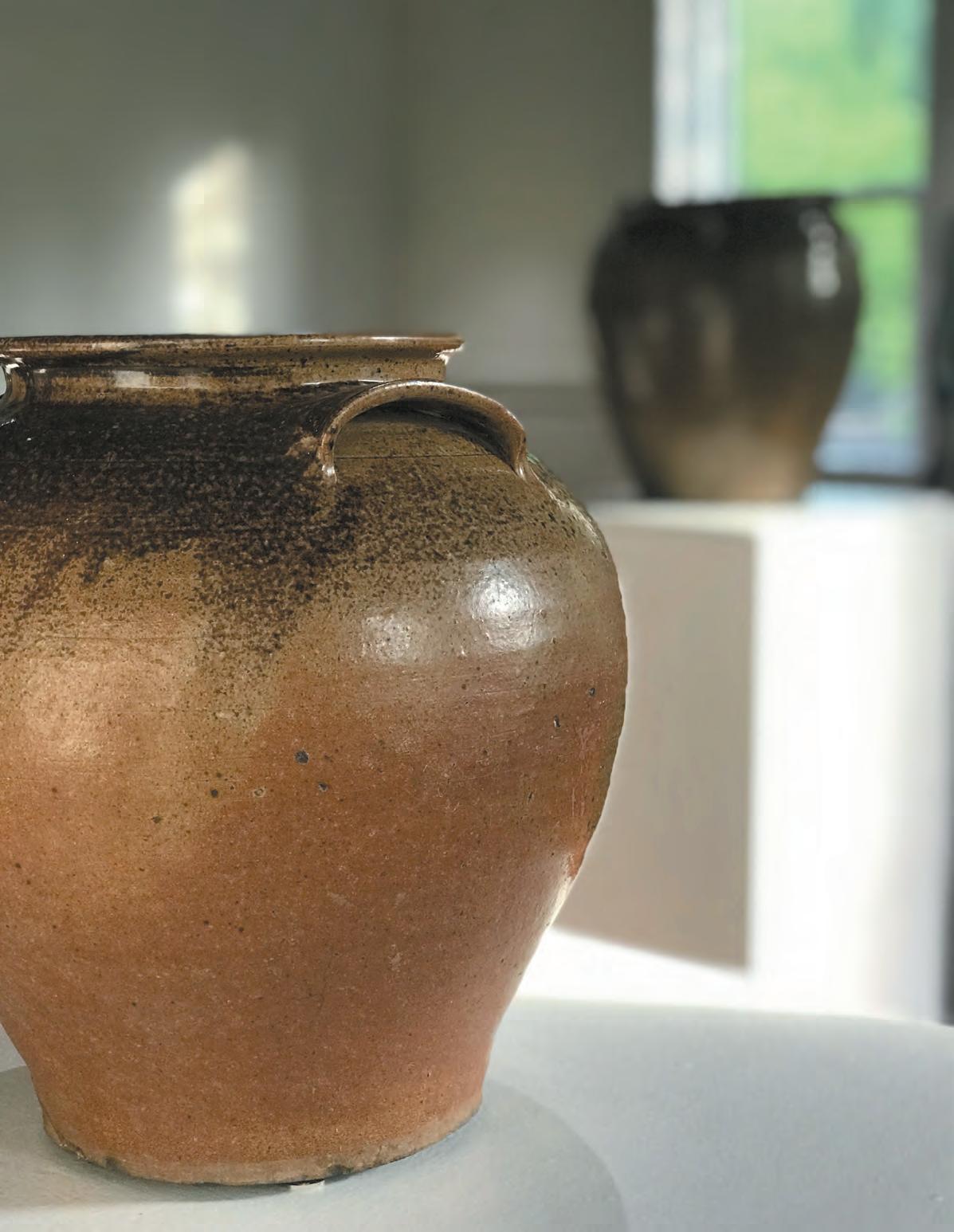
6 minute read
$1 MILLION IMPACT ONE JAR,
Madison-Morgan Cultural Center’s precious ‘Drake jar’ finds a new home at the National Gallery of Art
STORY BY PATRICK YOST
For years, the National Gallery of Art in Washington, D.C., has kept Madison on its acquisition radar. At the core of the gallery’s interest was a 21.5” tall vessel that had filled a lonely spot in the Madison-Morgan Cultural Center’s Piedmont History section.
The jar, donated to the Center in 1991, was created by David Drake, an enslaved African-American man who worked and lived on various plantations in the Edgefield, S.C., area in the mid to late 1800s. Drake’s work has found incredible value in the past 20 years, in part because the jars are signed and at least 40, including the Center’s, had a message inscribed at a time when it was against the law for people who were enslaved to both read and write.
Drake’s work, a New York Times piece states, “points to the artistic achievements of enslaved African Americans and the persistent erasure of their work from America’s cultural institutions for nearly 300 years.”
In November 2021, the Times piece says, a Drake jar was auctioned at Brunk Auctions in Asheville, N.C. The estimate, at the time for the jar, was between $40,000 and $60,000. Museums competed for the work and the final price was $369,000.
In January of this year, the Cultural Center, after having several discussions with the National Gallery of Art, sold the Center’s David
Drake jar directly to the gallery for $1,000,000.
“The work has long been known and its location recorded,” says Anabeth Guthrie, chief of communications, National Gallery of Art. “When we first encountered the work at the MMCC, it affected us powerfully, as happens with all of Dave’s greatest storage vessels. The sheer size, the alluring glaze and the inscription— both the signature and the enigmatic poem— combined to remind us why Dave was one of the outstanding artists active in the South in the 19th century.”
According to Cynthia Huger, executive director, MMCC, the Center’s board struggled with the concept of the “deaccession” of Drake’s jar, in part because of the idea that it was gifted to the Center. The Center, she says, organized a five-person committee to answer a basic question. “Do we really want to sell this object?”
The tan colored jar with a greenish glaze weighs 56 pounds. When in 2022, local residents Teresa Bramlette Reeves and Clare Wolfe organized an “Earth Bound” exhibit of the David Drake jars at the Cultural Center, they did so, according to an interview with the Morgan County Citizen, in part because its importance was hidden in the Piedmont History section.
“We were poking around there one day and came upon the Drake jar seemingly hidden deep in the corner of the Piedmont History section,” Wolfe wrote. “We thought, we have got to do something with this astonishing piece of art!”

The pair curated the “Earth Bound” exhibit at the Cultural Center and found four other Drake jars from the Madison area to surround the large jar owned by the Center. Accord- ing to Huger, the “Earth Bound” exhibit drew between 100 to 150 people to the Center during its run.

David Drake was an enslaved stoneware potter born in Edgefield, S.C. His works shine a light on the beauty of craftsmanship along with their complex cultural legacies. They are made more valuable by Drake’s defiant act of signing his name and sometimes inscribing short poems on the stoneware during a time when literacy was outlawed for people who were enslaved.
The National Gallery, she says, draws 3 million to 4 million people annually. At present, the Center’s Drake jar is sitting ensconced in protective glass in the National Gallery’s ground floor. In the fall, according to the MMCC, the jar will be “installed on the West Building’s main floor, displayed among a collection of paintings from Drake’s lifetime.”
“Through exhibition, interpretation, and digital storytelling, David Drake’s work will help us expand the story of American art.
How It Came to the Madison-Morgan Cultural Center:
In a letter dated Nov. 11, 1991, Mrs. Harwell Stovall, Southern Pines, N.C., sent a handwritten letter to the Cultural Center. The letter states that a few weeks prior, Mrs. Stovall and her husband had visited the Cultural Center. “We inquired if the Center would have interest in preserving and displaying an urn and wooden rocker which belonged to Mrs. Little Berry Stovall (1871-1963) who for many years lived on Central Avenue in Madison,” the letter states.
The “urn” in question was a massive David Drake jar. An inscription on the jar, the letter states, says the jar was made by “Dave” in March 25, 1859. On the opposite side of the jar is the inscription “If you do not lisen at the bible you will be lost.”
According to the Times piece, there are approximately 40 Drake jars in existence that have an inscription and these works are especially prized because they represent defiance to a law that forbid enslaved people from reading and writing.

Mrs. Stovall told the center that Mrs. Little Berry Stovall had come to Morgan County after marriage from Greene County and had initially moved to the Apalachee area. When Mrs. Little Berry Stovall moved “into town” the jar came with her. “It had been used for storing lard in a cellar,” Mrs. Stovall wrote.
In response, then Arts Management Consultant Corinne Anderson wrote back to the Stovalls that the gifts would “greatly enhance our exhibition that reflects the life of the Piedmont area of Georgia.”
The Stovalls also donated a wash stand, cabbage grater, clay marbles, a child’s writing slate, crossbow and puzzle.
“It is apparent from reading your letter that you have researched the articles quite thoroughly and that they are very meaningful to you and, therefore, it is very lovely of you to think of us. Your letter made us feel as if Christmas had arrived early this year,” Anderson wrote.
Huger says she reached out, both in mail, certified mail and through attempted phone calls to Mrs. Stovall’s surviving son to discuss the Center’s contemplation of selling the jar. The certified letter, she says, was signed for but no response was made.
$1,000,000 Impact:
According to Huger, prior to the sale of the jar, the museum’s board contemplated what it could do both ethically and prudently with the proceeds. The million dollar offer, she says, “was a fair market offer.” “We weren’t seeking to sell this jar,” she says. ”The board felt like it was a fair price.”
However, with the sale, the board, according to its bylaws, is restricted in how to utilize the funds. Huger says by the Center’s bylaws, no money from the sale can be used for operations. She says the David Drake jar proceeds will enhance the Center’s endowment fund by $600,000; raising that endowment to $2.2 million, she says.
Another $200,000 is going to be spent restoring, re-thinking and updating the Center’s Piedmont History Museum, the same museum that for years housed the David Drake jar “hidden deep in the corner.”

Work on the Center’s Piedmont History Museum is expected to take “several years,” Huger said.
The remaining $200,000 will be used to create the “Andrews Legacy Project.” The project, Huger said, will be a permanent exhibition detailing both the era of share-cropping in Morgan County and the estimable work of Morgan County’s Andrews family including the noted artist Benny Andrews, writer Raymond Andrews and their father George Andrews, a well-known folk artist known as “The Dot Man.”
That exhibit, Huger says, should give guests the experience of being in a share cropper’s home. “We want you to feel as if you’re in the Andrews’ house,” she says. It will also feature art work from both Benny Andrews and George Andrews. “We will show works of Benny’s that have never been seen,” she says.
That exhibition is expected to open with great fanfare in October 2023.
Final Resting Place:
In an email, Huger sends a photo of the David Drake jar at the National Gallery. It shows the storage jar set amid protective glass and on a pedestal highlighted by inner illumination. The sale, Huger contends was “a benefit to the jar.”
“Millions of visitors will now have the opportunity to see the work annually,” Guthrie says. “The National Gallery of Art is the most attended art museum in the United States.”
Huger says the Gallery also has an online visitor component that reaches more than 20 million people.
“We didn’t have the context of a collection that would make people appreciative in the same way that a collection of David Drake at the Gallery will,” Huger says. “The way they are dis- playing this jar now… it is a focal point. It’s major.” the
Guthrie says the Gallery had no qualms about purchasing the jar and says its importance is not lost on the institution. “The National gallery of Art’s focus, since our founding, has always been acquiring outstanding works of art,” she says.
“Among his largest works, it is a sterling example of Dave’s talents as a potter and a poet. The moving poem captures his deeply rooted spirituality, and its powerful first line will inspire curiosity. The acquisition also represents a major leap forward for the National Gallery in our collecting of decorative arts—the first ceramic to be purchased. The jar has various contexts at the National Gallery, both as a great example of American art and as a work that will make our ceramics collections more inclusive, joining the great examples of Italian and French Renaissance pottery and Chinese porcelains that we already have. It also becomes the most important work of American ceramics in the collection, joining only a handful of examples in the Kaufman collection,” Guthrie says.
Huger says the sale of the jar, the impact that sale will make on the venerated Cultural Center and the history behind the work is serendipitous. “It was meant to be,” she says.
















